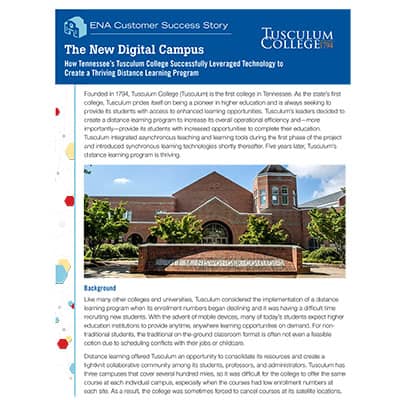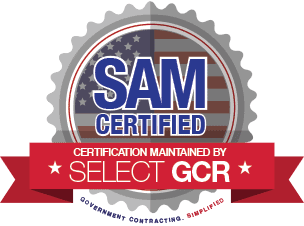Customer Success Story
How Tennessee’s Tusculum College Successfully Leveraged Technology to Create a Thriving Distance Learning Program

Founded in 1794, Tusculum College (Tusculum) is the first college in Tennessee. As the state’s first college, Tusculum prides itself on being a pioneer in higher education and is always seeking to provide its students with access to enhanced learning opportunities. Tusculum’s leaders decided to create a distance learning program to increase its overall operational efficiency and—more importantly—provide its students with increased opportunities to complete their education.Tusculum integrated asynchronous teaching and learning tools during the first phase of the project and introduced synchronous learning technologies shortly thereafter. Five years later, Tusculum’s distance learning program is thriving.
Background
Like many other colleges and universities, Tusculum considered the implementation of a distance learning program when its enrollment numbers began declining and it was having a difficult time recruiting new students. With the advent of mobile devices, many of today’s students expect higher education institutions to provide anytime, anywhere learning opportunities on demand. For nontraditional students, the traditional on-the-ground classroom format is often not even a feasible option due to scheduling conflicts with their jobs or childcare.
Distance learning offered Tusculum an opportunity to consolidate its resources and create a tight knit collaborative community among its students, professors, and administrators. Tusculum has three campuses that cover several hundred miles, so it was difficult for the college to offer the same course at each individual campus, especially when the courses had low enrollment numbers a teach site. As a result, the college was sometimes forced to cancel courses at its satellite locations. Tusculum’s large geographic footprint also made it difficult for its faculty members to collaborate and communicate on a frequent basis.
Getting Started
Dr. Blair Henley, Tusculum’s vice president and chief technology officer, recognized the necessity of having a strong infrastructure in place to support the college’s new online learning platform. Dr.Henley worked with Education Networks of America (ENA), Tusculum’s Internet service provider, to ensure the college had the bandwidth it needed to sustain and grow its digital initiatives. Tusculum also deployed ENA Air, ENA’s turnkey Wi-Fi solution, to provide its students with seamless campus wide connectivity.
Scalability and Mobility
Tusculum’s initial foray into videoconferencing was so successful that it quickly needed to expand the program’s reach. When the Tandberg technology’s$200,000 price tag proved to be too cost-prohibitive for long-term sustainability, Dr. Henley reached out to ENA for a solution. After reviewing a number of options, Tusculum decided to deploy Video Collaboration Powered by Zoom (VCPZ), a cost-effective, cloud based video conferencing solution available from ENA. Tusculum selected VCPZ because of its versatility, mobility, and cost-effectiveness.
Its users can access the solution on their laptops, tablets, and smartphones, enabling them to engage in videoconferencing experiences from any location at any time. Video collaboration tools make meetings and webinars come alive, supporting large and small group break outs as well as collaboration at a distance with shared content and annotation features. Because the technology is cloud-based, faculty members can use their laptop or desktop computers to broadcast, stream, or record their lectures. The technology can also be used to host large group meetings and webinars. Unlike the Tandberg equipment, VCPZ’s low price point makes it a very sustainable, flexible, and scalable technology, enabling Tusculum to enhance and grow its distance learning program.
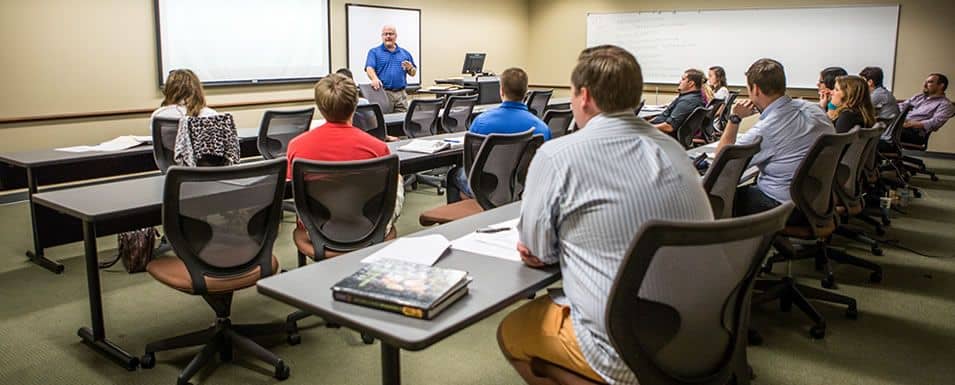
Leading the Way
Asynchronous learning systems have been employed by higher education institutions for many years, but Tusculum’s distance learning program is unique because it provides students with access to both asynchronous and synchronous learning opportunities. Using VCPZ, Tusculum’s students can participate in real-time classes and interact with their peers and instructors from any location. Tusculum has removed the geographical barriers that hinder many individuals from pursuing a post-secondary degree and made learning more flexible for its students. Additionally, the introduction of video technology has enabled Tusculum to expand and diversify the courses it offers at all of its campus locations. It no longer has to cancel a course due to low enrollment numbers—affording its students more learning opportunities.

Key Beneficiaries
This program has greatly benefited Tusculum’s students and faculty members as well as the region’s high school students. Students have the opportunity to synchronously participate in courses using the video conferencing technology, or they can asynchronously participate using an online learning management system. This flexibility opens the door to a plethora of new learning opportunities unhindered by geographic barriers or schedule conflicts, allowing students to earn their post-secondary degrees at any time from any location. Additionally, they also have more access to their professors and instructors, enabling them to gain valuable feedback regarding their coursework and academic performance.This program has been immensely beneficial for Tusculum’s faculty members as well. The college is using the program to combine course sections that it normally would have cancelled due to low enrollment, providing Tusculum’s instructors with more opportunities to teach.
The technology is also being used to facilitate faculty and departmental meetings. Because Tusculum has three campuses, it was historically very difficult for departments to meet and collaborate, but video conferencing allows the college’s instructors to regularly meet “face-to-face”via their laptops, tablets, or smartphones to exchange ideas, discuss pressing issues, etc.Tennessee’s high school students are also benefiting from Tusculum’s distance learning program.They are using the college’s online learning management system and VCPZ solution to participate in its dual enrollment program. This technology is enabling Tennessee’s high school students to earn college credit without having to set foot on Tusculum’s campus.Additionally, Tusculum’s community members and stakeholders are other beneficiaries of the program. The college is using the technology to stream graduations and town hall meetings. If a family member is ill, traveling for work, or in the military, they still have the ability to watch Tusculum’s graduation ceremony.
Beginning in January 2016, Tusculum started using VCPZ to bridge class sections among all three campus and off campus locations. As evidenced by the usage data represented to the right, the tool has been well-received by the college’s students and faculty members.
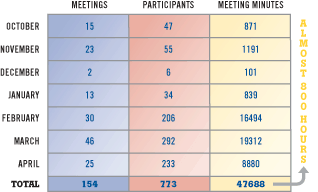
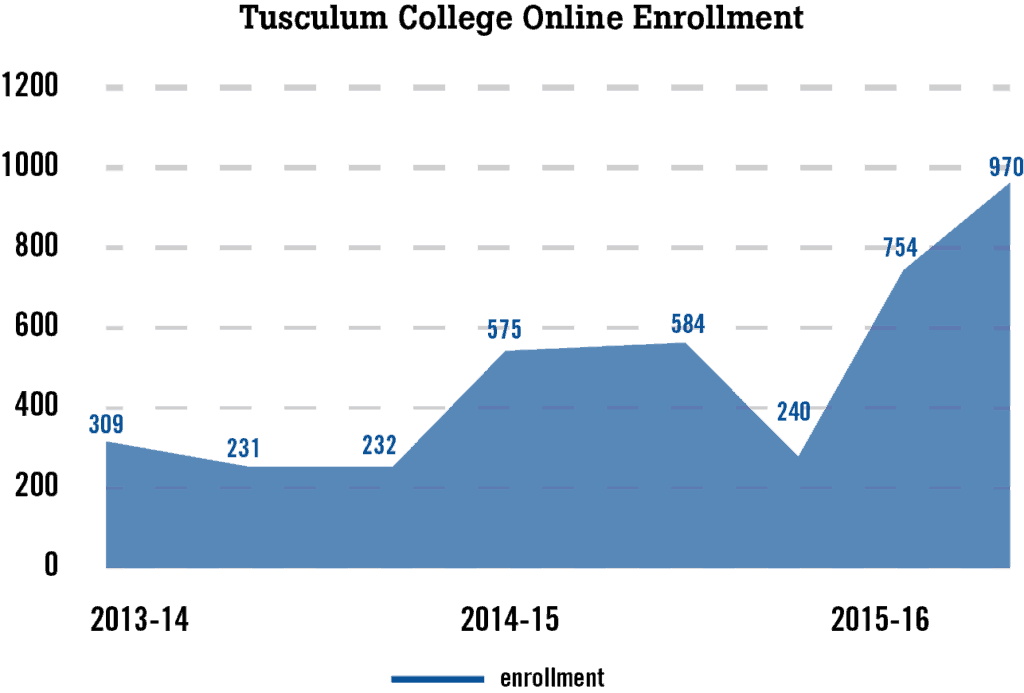
Next Steps
Tusculum intends to continue growing and enhancing its thriving distance learning program. The college will be offering an online Associate degree in the fall of 2016. It will continue to make more courses available online and allow its students to participate via video conferencing. The college anticipates that the higher education learning landscape will look much different in five years, and Tusculum’s team is planning accordingly. Today’s K–12 students are very tech-savvy, and many of them have already experienced distance education in some format. Tusculum wants to ensure it can meet the needs of these incoming “digital natives,” as these students will most likely be basing their college selection on convenience of participation and speed of degree completion.

As evidenced by the statistics listed above, Tusculum’s distance learning program is drastically changing the learning landscape for its students. With more flexible learning opportunities available to them, the college’s busy students can now earn their degrees while balancing internships,rigorous class schedules, jobs and careers, and childcare. By leveraging innovative technologies like Video Collaboration Powered by Zoom to bridge distance gaps and foster meaningful collaborations, Tusculum has created a fruitful, sustainable, and cost-effective distance learning program that will help the college meet its present and future student recruitment, satisfaction, and retention goals.
Recommendations
For those colleges and universities interested in replicating Tusculum’s success, Dr. Henley has puttogether the following list of recommendations:
1. Get your infrastructure established first. If you do not have the capacity to support this typeof program sufficiently, your audience will not have a good experience and will most likelynot support it.
2. Choose the technology that best fits your desired outcomes. Technology is not the end-all, be-allsolution, and it needs to be selected very carefully based on what you want your outcome to be.
3. Always have a backup plan. As with any technology implementation, do not rely on it alone.Have a solution in place if the technology fails.
4. Create a beta program or lab environment. Allow users to experience the technology in anon-threatening and non-critical environment. It gets them comfortable with the technology.
